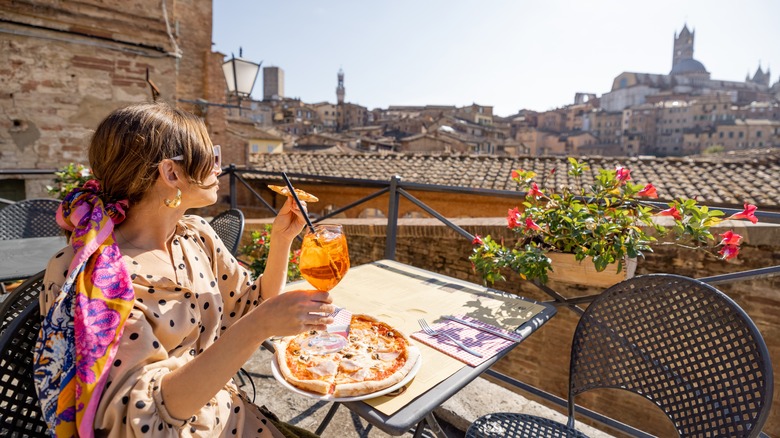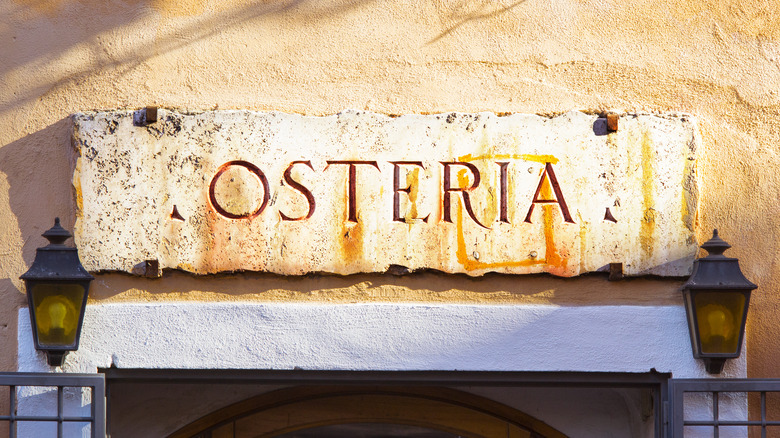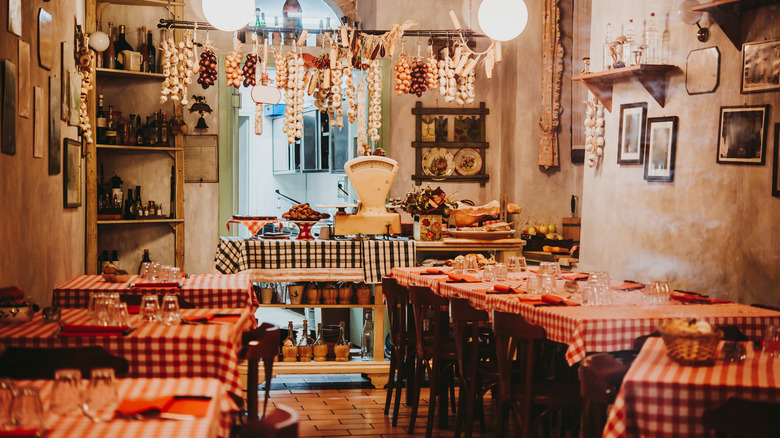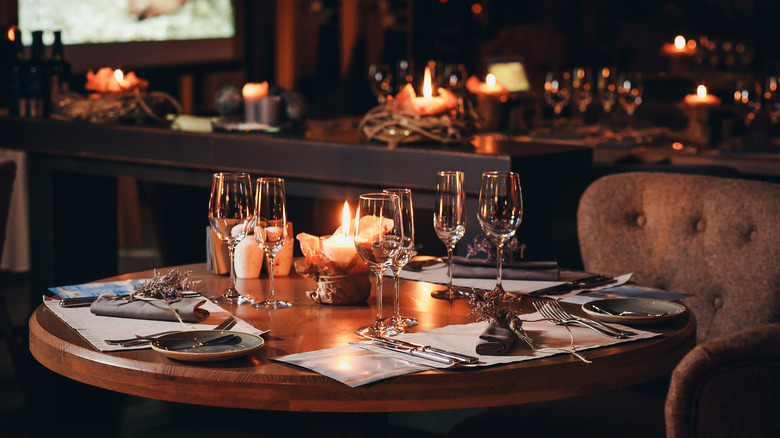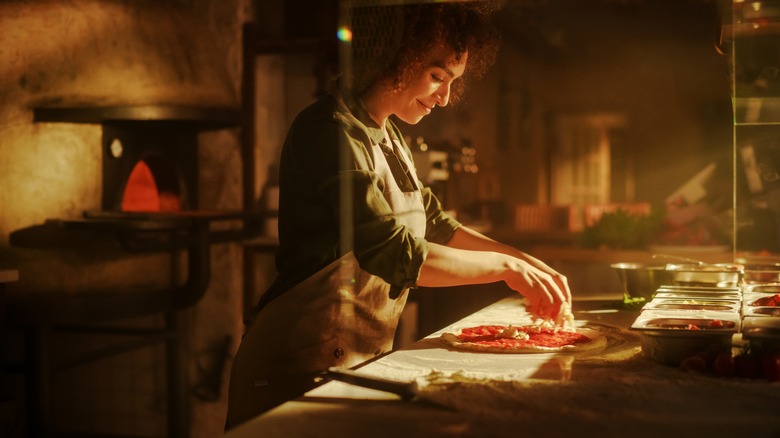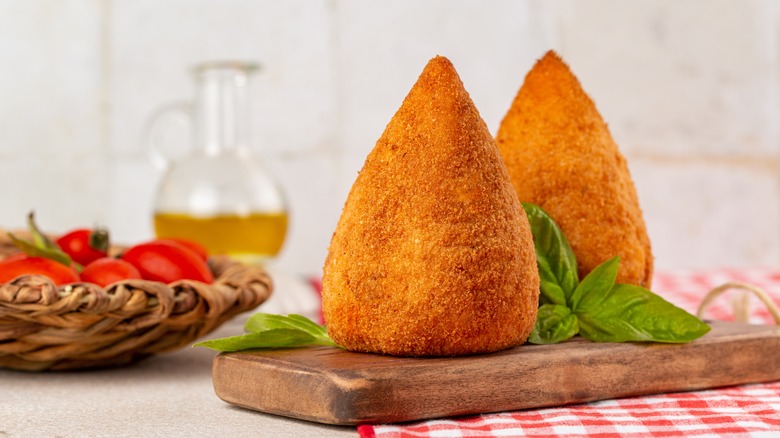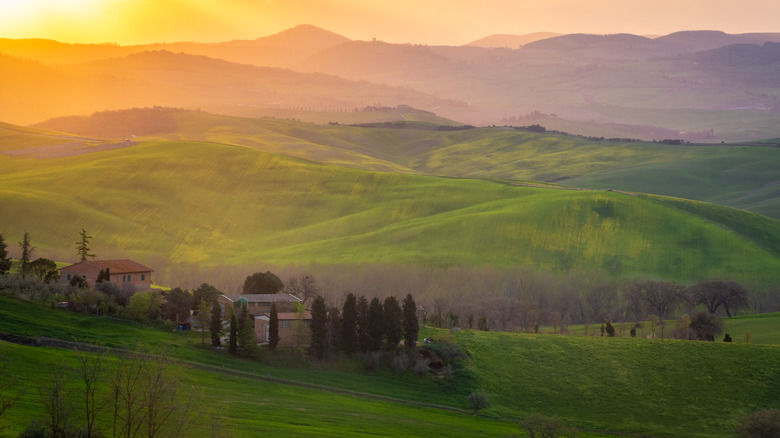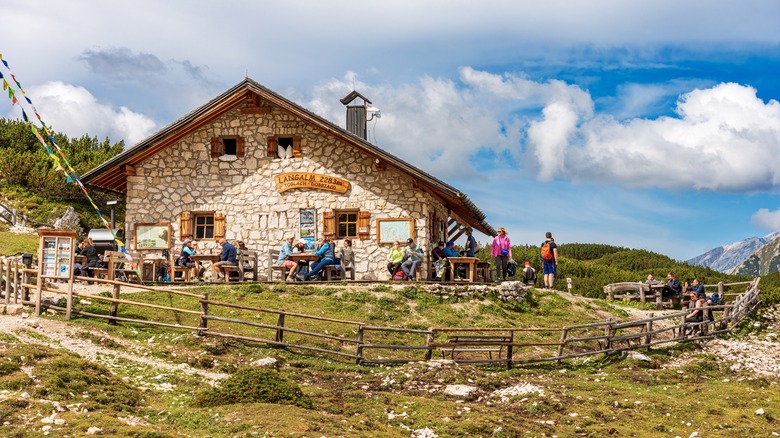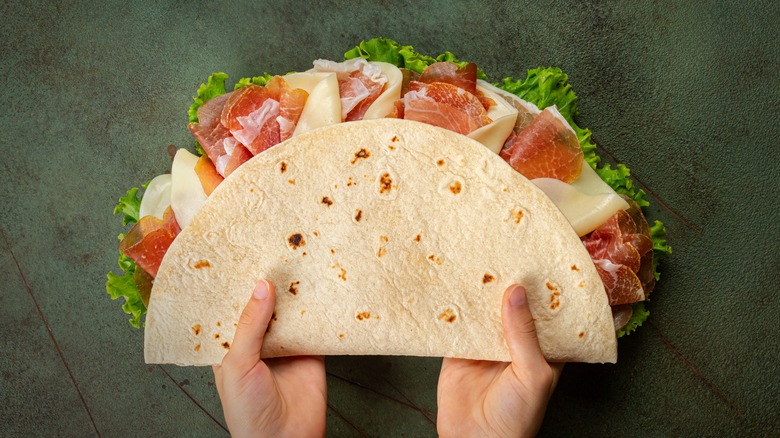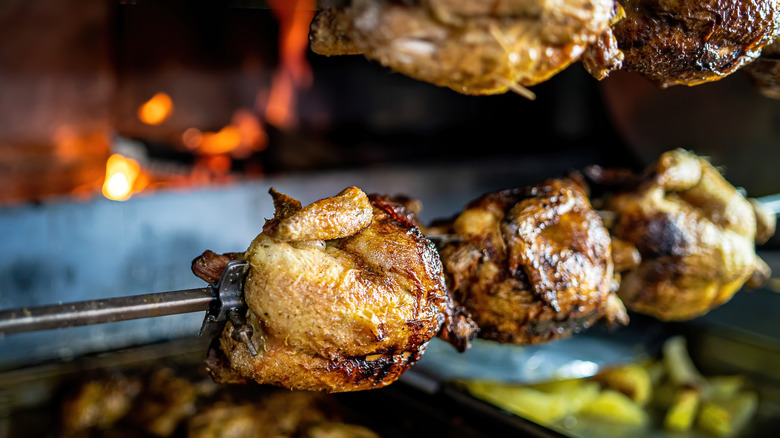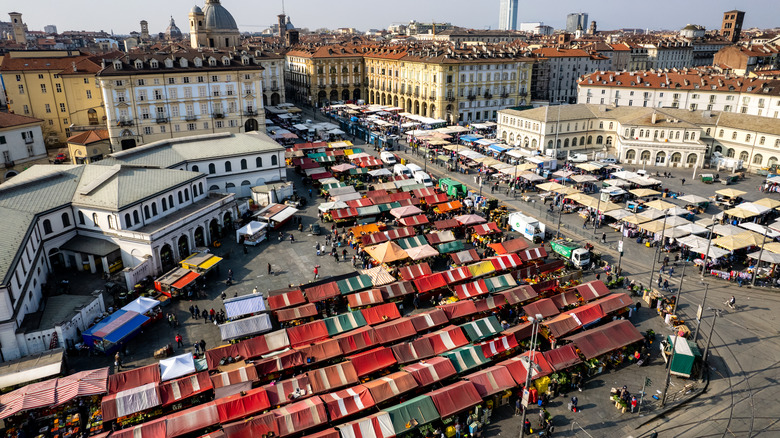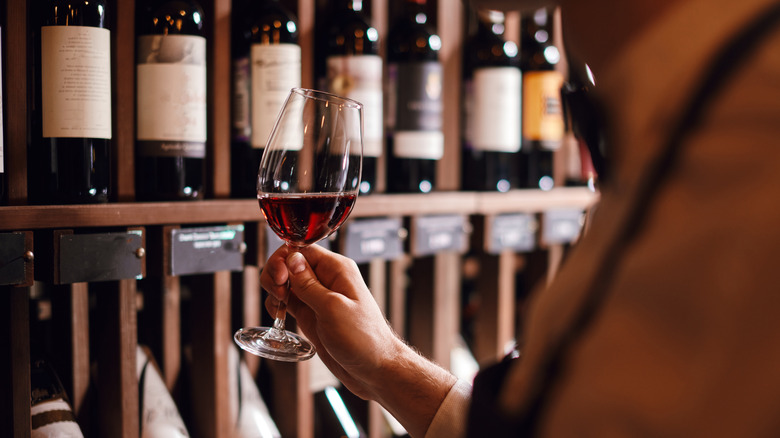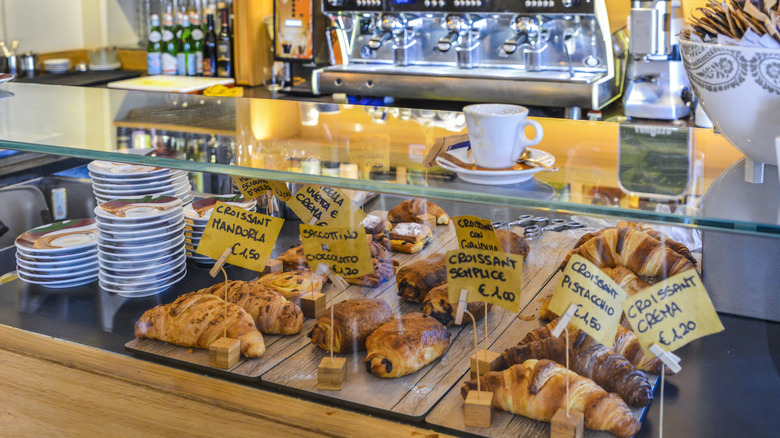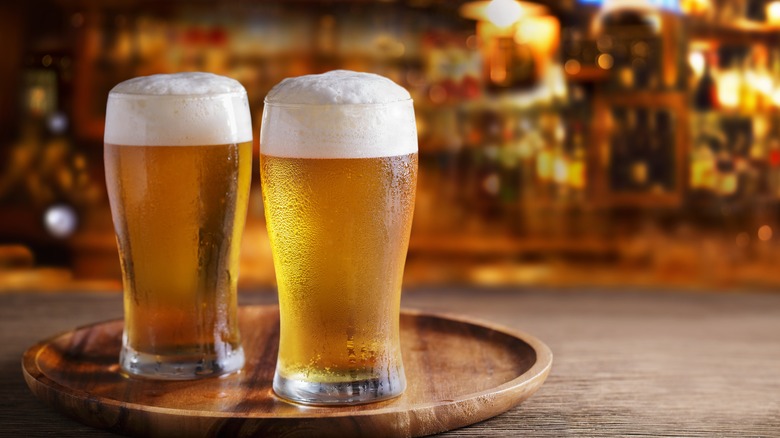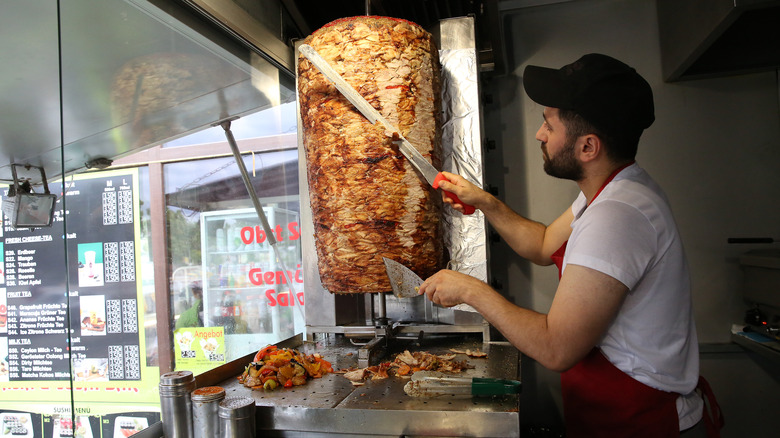14 Types Of Restaurants In Italy, Explained
Dining in Italy is the best way to experience Italian food, and unless you've fallen into a tourist trap, you'll find it's world famous for a reason. Of course, if you can't make it to Italy, check out the best Italian restaurants in New York City, Chicago, and Los Angeles instead. Understanding the different kinds of Italian restaurants can be confusing and even intimidating for travelers. English speakers understand what a pizzeria is, but what's the difference between an osteria and a trattoria? If there are so many kinds of restaurants, which one is actually a ristorante? Why do Italians go to a bar at 8 am?
The precise distinction between the kinds of restaurants isn't always clear to Italians, either. Some types of establishments had very different historical origins, but the lines have become blurred over time. Others may be a combination of more than one kind of restaurant.
The choices may be confusing at first, but with a little knowledge of the types of Italian restaurants under your belt, it will be easier to choose what kind to try (or, better yet, try them all!). Then all that's left will be to sit back and enjoy a meal with excellent food and wine, breathtaking views, and good company that is the magic of Italy.
Osteria
An osteria, in general terms, is a restaurant that is less formal than both a trattoria and a ristorante. The word comes from a twelfth-century French word for innkeeper or host ("oste"), and traditionally, an osteria was an inn that offered both sleeping quarters and homemade meals, and it was also a popular place to drink and gather. The modern osteria is no longer an inn but a modest and welcoming restaurant known for its humble atmosphere and low prices. The focus then and now is still local wine, good food, and good company.
Originally you could expect to sit at a communal table, and you will still find some that offer wooden tables and benches shared with other diners. The menu may be written on a chalkboard on the wall, or a small selection of choices may simply be recited by the waiter. Menu items are unassuming regional dishes, but unless you've fallen into a tourist trap, expect delicious food.
If you're fortunate enough to find a true Italian osteria, enjoy one of these traditional gems of the country. Beware certain modern restaurants, notably Chef Massimo Bottura's Osteria Francescana in Modena, that have adopted the name. Unlike the original inns accommodating travelers or drinkers, this Michelin-starred restaurant is famous for its fine dining.
Trattoria
A trattoria is, generally speaking, a restaurant that is more formal than an osteria but less formal than a ristorante. The name is derived from the French word "traiteur," which means host, making the real distinction between an osteria and a trattoria a bit blurry. The trattoria also has popular origins as it was frequented by travelers and workers as a more economical alternative to a restaurant. Compared to a ristorante, a trattoria is more affordable, and the décor and the level of service is simpler but welcoming.
The trattoria has certain characteristics that have been preserved over time and continue to attract food lovers, whether they be locals or tourists. You can expect an informal atmosphere, high-quality dishes made with local ingredients, and a wide selection of Italian wines. The difference between a trattoria and an osteria, besides the former having a larger menu, is that a trattoria is traditionally family-run. Recipes, which are prepared in a homemade and simple style, may be passed down through the generations, and one family's version of a dish may differ from the same dish offered in other establishments in the area.
Ristorante
An Italian ristorante — yes, it means restaurant, is the most formal kind of eating establishment in Italy. Some may be cozy and small, while others offer a formal atmosphere and fine dining. This is where Michelin stars are found. In general, a ristorante is more expensive than a trattoria or an osteria, and the fanciest will have high prices to match. Don't look for a chalkboard menu. Patrons will receive a printed menu with a larger selection of dishes than those found in the other types of restaurants. While a trattoria and an osteria focus on regional dishes, a ristorante is where to go to sample, besides Italian cuisine, a wider range of culinary styles and ethnic food like French, Brazilian, Spanish, or Japanese.
Full table service, multi-course meals, and a sommelier characterize these establishments. In a more formal restaurant you will be expected to order all the courses, from the "antipasto" (appetizer) to the "dolce" (dessert), but in a less formal one you can get away with ordering just a "primo" (first course) or a "secondo" (second course). Of course, if you're lucky enough to get invited to a ristorante for an Italian wedding, you can expect about three appetizers, two separate first courses of pasta, a second course with a "contorno" (side dish), and very good Italian wine to be served at your table (but make sure to leave room for the cake and dessert buffet).
Pizzeria
The pizzeria is a restaurant with table service, a menu, and a "pizzaiolo" (pizza maker), often working with a wood-burning oven. It can range from informal to fancy. A pizzeria only serves pizza, but many restaurants will serve pizza as an option along with a full menu of appetizers, first and second courses, and desserts. There is also "pizza al taglio," an informal establishment selling pizza by the slice. Slices will be wrapped in a convenient piece of cardboard or wax paper to keep your hands clean.
Pizza is one of the Italian foods best known abroad, but the genuine article may be different from what non-Italians expect. For starters, everyone gets their own pizza, which is served on a large plate and, according to the True Neopolitan Pizza Association, must not exceed 35 centimeters (13.8 inches) in diameter. When consumed at table, it is eaten with a knife and a fork. Despite Italians' love of wine, they pair their pizza with beer (or soda) because it's considered an informal food. Italian pizza has a lighter taste than its American counterpart because it's not made with tomato sauce but with simple tomato pulp or puree, which can be jarred or fresh. Leave your craving for Hawaiian pizza at home! While Italians may turn up their noses at pineapple topping, they are perfectly content to eat "pizza würstel e patatine" (pizza with hot dog and french fry topping). which according to Vanity Fair, is an Italian invention.
Tavola Calda
Literally meaning hot table, a "tavola calda" is an unpretentious and inexpensive business serving premade food made the same day and sold from behind a counter. Unlike a bar, which usually has a small selection of ready-to-eat sandwiches at lunchtime, a tavola calda offers a larger selection of dishes, which includes cooked food. Patrons wait in line to order, and their selection is available relatively quickly. The food may be hot or cold, with hot food reheated in an oven before being served. There will usually be a few small tables available to sit down and eat.
A tavola calda can be compared to a cafeteria, and some are, in fact, large and impersonal, but they can be smaller and intimate as well. Don't let the informal atmosphere fool you; unless it's a tourist trap, the food is usually good (yes, we are noticing a theme with Italian food here). Choose from a variety of pasta and rice dishes, baked pasta like lasagna, square pieces of pizza with a range of toppings, arancini (fried rice balls), quiche, stuffed dough items like panzerotti and hot dogs wrapped in dough, meat and fish dishes, roast chicken, a selection of vegetable sides, and desserts like pastries and slices of cake. The selection may change by the day.
Agriturismo
An "agriturismo," or farm stay, is a way to experience Italian hospitality off the beaten path. Small farms in Italy began struggling in the 1950s, and to safeguard the country's traditions of independent, local production of products like wine and olives, Italian law created allowances for the newly created agriturismo, in which rural buildings, many abandoned, could be converted into accommodations. Many are modest establishments run by working farmers who need additional income and who make extra rooms in their farmhouse available, and others focus on luxury for tourists. You may be accommodated in an extra bedroom, a converted outbuilding, or separate dedicated structure. In addition to room and board, many will also provide experiences in the countryside, such as horseback riding and cooking classes. This is an opportunity to experience Italian rural life firsthand, including at mealtime.
Meal ingredients are often the products of the farm itself, whether that be cheese, wine, olives and olive oil, vegetables, fruit, honey, chestnuts, eggs, chicken, pork, or beef. Prices are more affordable than staying in a traditional hotel with a restaurant, and you'll taste the kind of dishes the locals themselves prepare and eat, which are unpretentious and excellent. Don't expect the same meal in one agriturismo as you'd find in another one across the country. Italy has strong regional culinary traditions, and you'll enjoy the food and wine of the region (or often that one part of the region).
Rifugio
Picture it... you've hiked up a mountain for hours and are hungry and thirsty. You spy an inviting rustic stone and wooden building sitting on a small plain before breathtaking peaks. This is a "rifugio" or a mountain refuge. They dot the Alps, Apennines, and Dolomites of Italy and offer sustenance to hikers, skiers, and visitors alike. Those in hiking areas may only be accessible on foot, but some are well-known enough and reachable by road, that city dwellers drive up just for the delicious meal. Except for those in ski areas, they are normally closed during the colder months because of heavy snowfall in the mountains.
The mountain-style décor of the dining room is as comforting as the food if you avoid making eye contact with a stuffed mountain ibex or two. Order a beer or a glass of local herbal liqueur, or stay for a multi-course meal with wine. Prices are quite low and the food is excellent. Some offer inexpensive overnight accommodation as well.
At the Rifugio Monte Bianco, located at the snowy top of Mont Blanc, the highest peak in the Alps, and accessible by cable car, start with an appetizer of cured sliced meats with honey-drizzled chestnuts or fried fontina cheese with tomato fondue. Move on to a traditional dish of polenta served with sausage stewed in tomato sauce or perhaps a serving of pasta with rabbit sauce, thyme, and parmesan. Finish it off with a slice of homemade cake or a cup of artisan ice cream.
Paninoteca
The "paninoteca," or sandwich shop, takes its name from the Italian word for sandwich: "panino". When in Italy, don't order a panini, unless you're planning on eating more than one. "Panini" is the plural form of the singular "panino." Certain kinds will be heated up for you first (and marked with those characteristic brown lines) on what's known in the United States as a panini maker, but in Italy is just a plain old sandwich grill.
The paninoteca is a very informal place to eat, with counter service and small tables. It also serves hamburgers and fries, hot dogs, chicken wings, deep fried vegetables, salad, soft drinks, and beer. Italian sandwich bread ranges "pane casereccio" (a general term for classic crusty Italian bread in various shapes made in different regions with durum wheat), ciabatta, flat breads, baguettes, and a kind of softer round roll with square bumps on the top appropriately called a "tartaruga" (tortoise). There's even a popular kind of sandwich made on toasted white bread called, in fact, a "toast."
Another version of the paninoteca is the piadineria. It sells a sandwich called a "piadina," which is also the name of the bread — a round flat bread originally from a historical Central Italian region called Romagna. The bread is folded in half and filled with combinations of ingredients ranging from prosciutto crudo, mozzarella, and lettuce to salmon, smoked provola cheese, and mayo to roasted peppers and gorgonzola.
Rosticceria
The rosticceria is what Italians considered to be fast food, as in, food that was ready quickly, before McDonald's style fast food was introduced in Italy in 1985. Don't look for burgers. The name of the shop comes from the Italian word for roast ("arrostire"), and the principle attraction here is roasted meat, usually chicken, but sausage and pork as well. You can also find chicken wings and meat on skewers. These informal shops take orders from behind a counter and diners can eat at one of the small tables or take their food home. Despite the informal nature of the rosticceria, the quality is very good.
Besides roasted meat, a rosticceria offers other pre-prepared hot foods like roasted potatoes, potato croquettes, French fries, arancini, chicken wings, mini finger food pizzas called "pizzette," farinata (a flat baked chickpea dish), and stuffed olives. Also look for various savory pastry and fried items like "panzerotti" (deep fried dough stuffed with ham and cheese or tomato and mozzarella), calzones, "trottole" (mashed potato dough stuffed with mozzarella and deep fried), and "rustici" (characteristic puff pastry from Lecce filled with tomato, béchamel, and mozzarella). Similar to the rosticceria is the girarrosto, a smaller establishment that exclusively sells roasts chicken on a spit and roasted potatoes, again of very good quality.
Mercato
The "mercato" (market) is alive and well in Italy despite the appearance of modern supermarkets. Smaller towns may have one once a week, while cities host numerous markets every weekday morning and all day on Saturdays. This is where Italians shop for produce, bread, eggs, meat, fish, cheese, preserved food, and sweets. Prices are low and ingredients are fresh and flavorful.
Many cities have a large central market where you can also find delicious, characteristic, and inexpensive street food. Florence's Mercato Centrale is located on the first floor of the historic San Lorenzo Market. Don't miss sitting down to a bowl of "ribollita," a classic Tuscan soup made with Tuscan kale, white beans, and stale bread. In Livorno's Mercato Centrale, sample "cecina," a flat, baked chickpea dish similar to a large pancake that's served sliced. Ballarò, the oldest and largest market in Palermo, is well known for its street food.
Order "u pani câ meusa" (a sandwich made from veal entrails) if you're brave, or one with "panelle," Sicily's version of the chickpea pancake.
Another example is Torino's Porta Palazzo, the largest market in Europe. In and around the covered building at its heart are stalls selling inexpensive and delicious fish dishes, meat platters, pizza, savory pastries, Peruvian specialties, Moroccan tajine, and desserts. Not to be missed is a special building called the Mercato Centrale with about twenty stalls selling artisan beer, fish, burgers, bread, wine, bread, pasta, and pastry, to name a few.
Enoteca
The closest translation of the Italian "enoteca" is wine bar. It can be hard to put Italian restaurants into absolute categories, and the enoteca is no exception. Traditionally, an enoteca only sold wine, either by the glass to drink there or in bottles to take home, although eventually, many started serving appetizers, like Italian cheeses and smoked or cured meat plates, to accompany it. Nowadays, many of these establishments are also full-service restaurants that use the word enoteca to highlight their focus on wine. They range from the modest trattoria to famous restaurants like the Enoteca Pinchiorri in Florence.
This is the place for wine lovers. An enoteca may be run by professional sommeliers or it could be a family-run cellar. There is generally a large selection of high-quality wines, ranging from the inexpensive to the fine. In many cases, the selection is local and regional, but it may include wine from neighboring regions or international wines. You may also find liquors and spirits for sale.
Bar
The Italian bar is actually akin to a café. They are ubiquitous and seem to dot every street corner. This is where you'll see Italians lined up at the counter drinking their morning espresso or cappuccino. The focus of the bar in Italian culture is not just on the product consumed but on the experience and company, which is why you don't see Italians drinking coffee in take-out cups while hurrying down the street. Bars range from the small, no-frills versions frequented by local regulars to fancy historical establishments and those that offer full buffets at dinner time. The coffee will be excellent, regardless. Some are well-known for a particular product, like Caffè Al Bicerin in Torino, which serves their famous "bicerin," a hot drink made from coffee, chocolate, and cream, and which originated in the city.
Bars offer a selection of beverages, including coffee served in various ways, tea, fruit juice, soft drinks, and alcoholic beverages. Go in the morning for a hot brioche (a breakfast pastry similar to a croissant that can be plain or contain fillings like chocolate, cream, fruit jam, or pistachio cream). At lunchtime, there will usually be a selection of pre-made sandwiches, but some will function as a tavola calda and serve hot, pre-made food or fresh dishes like pasta that can be consumed at a table. In the afternoon or evening, Italians stop by the bar for a drink or aperitif, with the focus, as usual, on good company.
Pub/Birifficio
A pub (also known as a "birreria") is an informal establishment modeled after the British pub. These are very popular, especially among the younger crowd, and you'll be hard pressed to find a seat on the nights the local city's soccer team is playing an important game. In that case, get there early and be prepared for enthusiastic, noisy fans. Pubs serve a variety of beers on tap as well as bottled beers, wine, liquor, and cocktails. Food may include appetizers (anything from mozzarella sticks and onion rings to a classic Italian cured meat board, depending on the location), pizza and focaccia, hamburgers and fries, sandwiches, pasta, grilled meat dishes, and desserts.
The "birifficio," on the other hand, is a brewery specializing in artisan beer. The craft beer revolution, which started in the United States in the 1970s, eventually hit Italy, with the first Italian artisan breweries opening in 1996. Now there are around 900 of them in the country. In addition to a variety of excellent and creative craft beers made on the premises, you can enjoy a meal with waiter service, with offerings similar to what you can find in a pub.
Kebabbaro
A kebabbaro is a kind of very inexpensive Turkish fast food restaurant present in Italy that features döner kebab, a large piece of seasoned meat made with any combination of sliced veal, chicken, turkey, beef, and lamb. The meat is kept warm and rotates on a vertical spit in plain view ("döner" means to rotate in Turkish). It is not to be confused with the kind of kebab that refers to small cubes of meat roasted on personal-sized skewers.
The meat is shaved off in thin slices, dressed with your choice of lettuce, tomato, onion, white yogurt sauce, and hot sauce, and served with flat Arab bread either on a platter with rice and salad, in a sandwich, or rolled into a wrap. Vegetarians can have their sandwich or platter filled with crispy felafel instead. Often, a kebabbaro is also a pretty good pizzeria.
It's said the kebab originated in the Middle Ages when, during long voyages, Ottoman Empire warriors impaled meat on their swords before roasting it. The modern kebab actually comes from Germany, where Turkish immigrants created the dish. These shops are very popular in some parts of Italy, particularly in the cities of Torino and Milan, where they arrived in the 1990s with Middle Eastern immigrants. Not all Italians are happy with foreign foods, however, and the kebab shop was one of the non-Italian food establishments banned in Venice by Italian authorities in a controversial move purported to protect Italian heritage.
Static Media owns and operates Tasting Table and Mashed.
